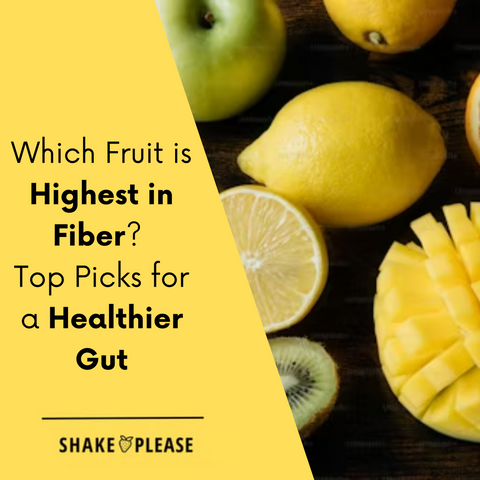
Maintaining a healthy gut is crucial for overall wellness, and one of the best ways to achieve this is through a high-fiber diet. Fiber plays an essential role in regulating digestion, promoting regular bowel movements, and supporting gut health. By incorporating more fiber-rich fruits into your diet, you can improve your digestive health while also gaining numerous other health benefits. This article will explore the top fruits high in fiber, how they benefit your body, and tips on increasing your fiber intake.
Understanding Dietary Fiber
Dietary fiber is a type of carbohydrate found in plant-based foods. Unlike other carbohydrates, fiber is not easily broken down by the body and passes through the digestive system relatively intact. While this might seem like a disadvantage, it is precisely what makes fiber so important for gut health.
Types of Dietary Fiber
There are two main types of fiber: soluble and insoluble. Both types play different roles in maintaining a healthy digestive system.
-
Soluble Fiber
Soluble fiber dissolves in water, forming a gel-like substance in the digestive system. This gel slows down digestion and can help regulate blood sugar levels and lower cholesterol.
Examples of Foods Rich in Soluble Fiber:
-
Fruits such as apples, pears, and citrus fruits
-
Vegetables like carrots and Brussels sprouts
-
Oats and barley
-
Legumes like beans, peas, and lentils
-
Insoluble Fiber
Insoluble fiber, on the other hand, does not dissolve in water. Instead, it adds bulk to the stool and helps food pass more quickly through the stomach and intestines.
Examples of Foods Rich in Insoluble Fiber:
-
Whole grains such as brown rice and whole wheat
-
Nuts and seeds
-
Vegetables like cauliflower, potatoes, and green beans
-
Fruits with skin, such as apples and pears
The Importance of Fiber Intake
Most adults do not consume the recommended daily intake of fiber, which is around 28 grams per day. Consuming enough fiber is essential for several reasons, including:
-
Promoting regular bowel movements: Fiber helps prevent constipation by adding bulk to the stool.
-
Maintaining healthy blood sugar levels: Soluble fiber helps slow the absorption of sugar, which can prevent spikes in blood sugar levels.
-
Supporting weight management: High-fiber foods are more filling, which can help reduce overeating.
-
Reducing the risk of chronic diseases: A diet high in fiber can lower the risk of heart disease, type 2 diabetes, and certain types of cancer.
How Fiber Supports Gut Health
Fiber serves as a food source for beneficial bacteria in the gut, promoting a healthy gut microbiome. A balanced microbiome is essential for a strong immune system, proper digestion, and even mental health.
Top High-Fiber Fruits
Fruits are a great source of both soluble and insoluble fiber. Here are some of the top fruits that are packed with fiber:
1. Passion Fruit
Passion fruit is one of the highest-fiber fruits you can find. With about 24.5 grams of fiber per cup, it can significantly contribute to your daily fiber needs.
2. Guava
Guava is another fiber-rich fruit, providing about 8.9 grams of fiber per cup. It’s also packed with vitamin C and antioxidants, making it a great choice for overall health.
3. Raspberries
Raspberries are not only delicious but also high in fiber, with 8 grams of fiber per cup. They are a versatile fruit that can be added to smoothies, salads, or eaten on their own.
4. Pears
Pears are an excellent source of fiber, particularly when eaten with the skin. A medium pear contains about 6 grams of fiber.
5. Apples
Apples are another fiber-rich fruit, especially when eaten with the peel. A medium apple provides about 4.5 grams of fiber.
Fruits High in Fiber and Low in Sugar
If you’re looking for fruits that are high in fiber but low in sugar, here are some top options:
1. Avocado
Avocados are unique in that they are low in sugar and high in both healthy fats and fiber. A medium avocado contains around 10 grams of fiber and only 0.2 grams of sugar.
2. Berries
Berries such as raspberries, blackberries, and strawberries are high in fiber and relatively low in sugar. For example, a cup of raspberries contains about 8 grams of fiber but only 5 grams of sugar.
3. Citrus Fruits
Citrus fruits like oranges, lemons, and grapefruits are another great option. They are low in sugar but can provide 2-3 grams of fiber per serving.
DISCOVER THE TOP FRUITS WITH HIGH PROTEIN CONTENT
Dried Fruits High in Fiber
Dried fruits can be a convenient way to increase your fiber intake, but be mindful of their higher sugar content. Here are some of the best-dried fruits for fiber:
1. Dates
Dates are incredibly high in fiber, with 14 grams of fiber per cup. They are also naturally sweet, making them a good substitute for sugary snacks.
2. Prunes
Prunes are well-known for their ability to support digestive health, providing 12 grams of fiber per cup. They are particularly effective in preventing constipation.
3. Apricots
Dried apricots contain about 3.3 grams of fiber per cup, making them a good snack for boosting fiber intake.
Tropical and Berry Fruits High in Fiber
Some of the best high-fiber fruits come from the tropics or are part of the berry family. These fruits not only taste great but also pack a significant fiber punch.
1. Passion Fruit
With 24.5 grams of fiber per cup, passion fruit is one of the top tropical fruits for fiber. It’s also rich in antioxidants.
2. Guava
Guava provides around 8.9 grams of fiber per cup and is also high in vitamin C.
3. Raspberries
Raspberries provide about 8 grams of fiber per cup and are one of the best berries for fiber.
4. Blueberries
Blueberries may not be as high in fiber as raspberries, but they still provide a decent amount, with 3.6 grams of fiber per cup.
5. Strawberries
Strawberries offer about 3.8 grams of fiber per cup, making them another great option for adding fiber to your diet.
Tips for Increasing Fiber Intake
Increasing your fiber intake doesn’t have to be difficult. Here are some simple ways to add more fiber to your diet:
1. Eat Whole, Unprocessed Foods
One of the best ways to increase your fiber intake is to focus on eating a variety of whole, unprocessed foods such as fruits, vegetables, whole grains, and legumes.
2. Incorporate High-Fiber Fruits
Add high-fiber fruits like avocados, berries, and citrus fruits into your meals or snacks. These fruits are not only rich in fiber but also loaded with other essential nutrients.
3. Gradually Increase Fiber Intake
If you’re not used to eating a high-fiber diet, start by gradually increasing your intake to give your digestive system time to adjust.
4. Stay Hydrated
Fiber works best when it absorbs water, so make sure to drink plenty of water throughout the day to avoid constipation.
5. Consider Fiber Supplements
If you’re having trouble getting enough fiber from food alone, you might consider taking a fiber supplement. However, it’s always best to get your nutrients from whole foods when possible.
Benefits of a High-Fiber Diet
Consuming a high-fiber diet offers a wide range of health benefits, including:
-
Improved digestion: Fiber adds bulk to the stool and promotes regular bowel movements, reducing the risk of constipation.
-
Weight management: High-fiber foods are more filling, which can help you control your appetite and reduce overeating.
-
Blood sugar control: Soluble fiber slows the absorption of sugar, helping to maintain steady blood sugar levels.
-
Heart health: Fiber can help lower cholesterol levels, reducing the risk of heart disease.
-
Reduced risk of chronic diseases: A high-fiber diet has been linked to a lower risk of developing conditions such as type 2 diabetes, heart disease, and certain types of cancer.
Fiber and Gut Health
Your gut microbiome plays a critical role in your overall health, and fiber is essential for feeding the good bacteria in your gut. By eating a high-fiber diet, you can promote the growth of beneficial bacteria, which supports a healthy immune system and may even improve mood and mental health.
How Fiber Affects Blood Sugar Levels
One of the most significant benefits of fiber, particularly soluble fiber, is its ability to regulate blood sugar levels. Slowing the absorption of sugar and fiber helps prevent spikes in blood glucose, making it especially beneficial for individuals with diabetes or those at risk for the condition.
THE REMARKABLE BENEFITS OF NATURAL SUGAR COMPARED TO ADDED SUGAR
Fiber for Weight Management
If you’re looking to manage or lose weight, a high-fiber diet can be your best friend. Fiber-rich foods are more filling and tend to take longer to digest, which means you’ll feel fuller for longer and may be less likely to overeat.
The Role of Fiber in Preventing Constipation
Insoluble fiber adds bulk to your stool, which helps food pass more quickly through the digestive system. This can prevent constipation and keep your digestive tract running smoothly.
How to Incorporate More Fiber into Your Meals
Here are some practical tips to help you add more fiber to your meals:
-
Start your day with a high-fiber breakfast: Choose whole grain cereals or oatmeal topped with berries or nuts.
-
Add beans or legumes to your salads and soups: These are excellent sources of fiber.
-
Snack on fiber-rich fruits: Keep fruits like apples, pears, or raspberries handy for a quick, fiber-packed snack.
-
Choose whole grains over refined grains: Opt for brown rice, whole wheat bread, and quinoa instead of white rice or bread.
Common Myths About Fiber
There are several misconceptions about fiber. Here are some common myths:
-
Myth: Only fruits and vegetables contain fiber. Fact: Fiber is also found in whole grains, legumes, and seeds.
-
Myth: Fiber causes bloating and gas. Fact: While increasing fiber intake too quickly can cause these issues, gradually increasing fiber and staying hydrated can prevent discomfort.
-
Myth: Fiber supplements are just as good as fiber from food. Fact: Whole foods provide additional nutrients that supplements lack.
Fiber Supplements: Should You Consider Them?
If you’re unable to meet your fiber needs through diet alone, a fiber supplement can be helpful. However, it’s always best to aim for whole foods first, as they offer additional vitamins, minerals, and antioxidants.
Fiber-Rich Recipes for a Healthier Gut
Here are a few easy and delicious ways to incorporate more fiber into your diet:
-
Berry Smoothie: Blend a cup of raspberries with almond milk, spinach, and a banana for a high-fiber breakfast or snack.
-
Quinoa Salad: Combine cooked quinoa with black beans, corn, and avocado for a fiber-packed lunch or dinner.
-
Chia Pudding: Mix chia seeds with coconut milk and top with blueberries and almonds for a fiber-rich dessert or snack.
The Importance of Gradually Increasing Fiber Intake
If you’re not used to eating a lot of fiber, it’s essential to increase your intake gradually. A sudden increase in fiber can lead to bloating, gas, or stomach cramps. Start by adding a few more fiber-rich foods to your meals each day and give your gut time to adjust.
Conclusion
Incorporating more fiber into your diet can significantly improve overall health by supporting digestion, weight management, and reducing the risk of chronic diseases. To ensure you're meeting your daily fiber needs, consider adding high-fiber fruits like passion fruit, guava, and raspberries to your meals. If you're wondering which fruit is highest in fiber, passion fruit tops the list with its impressive fiber content. Knowing how much fiber you need and aiming for a fiber-rich diet can also positively impact other areas, such as brain health. Remember to gradually increase your fiber intake, drink plenty of water, and focus on consuming a variety of whole, unprocessed foods to enjoy the full benefits of a high-fiber diet.





